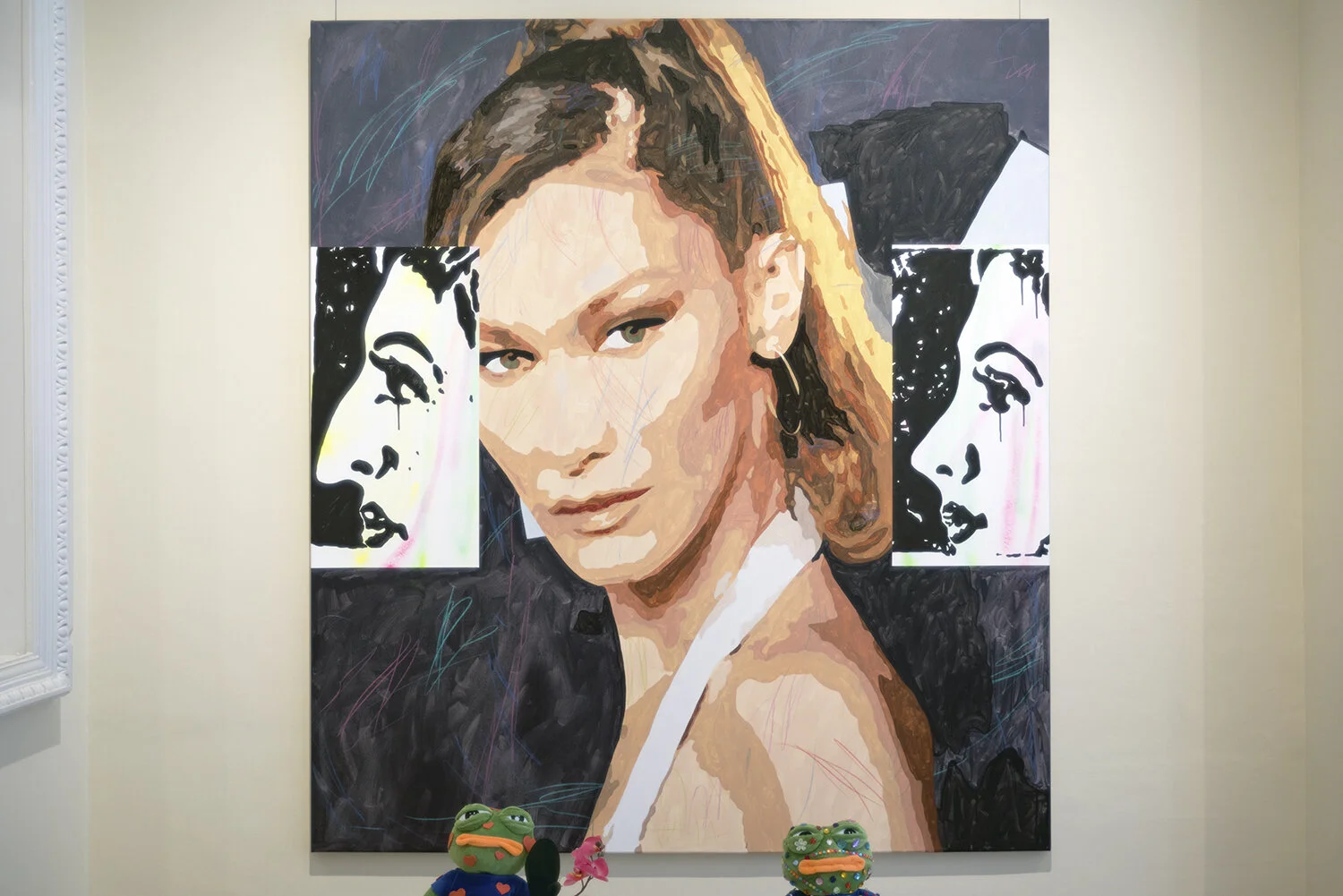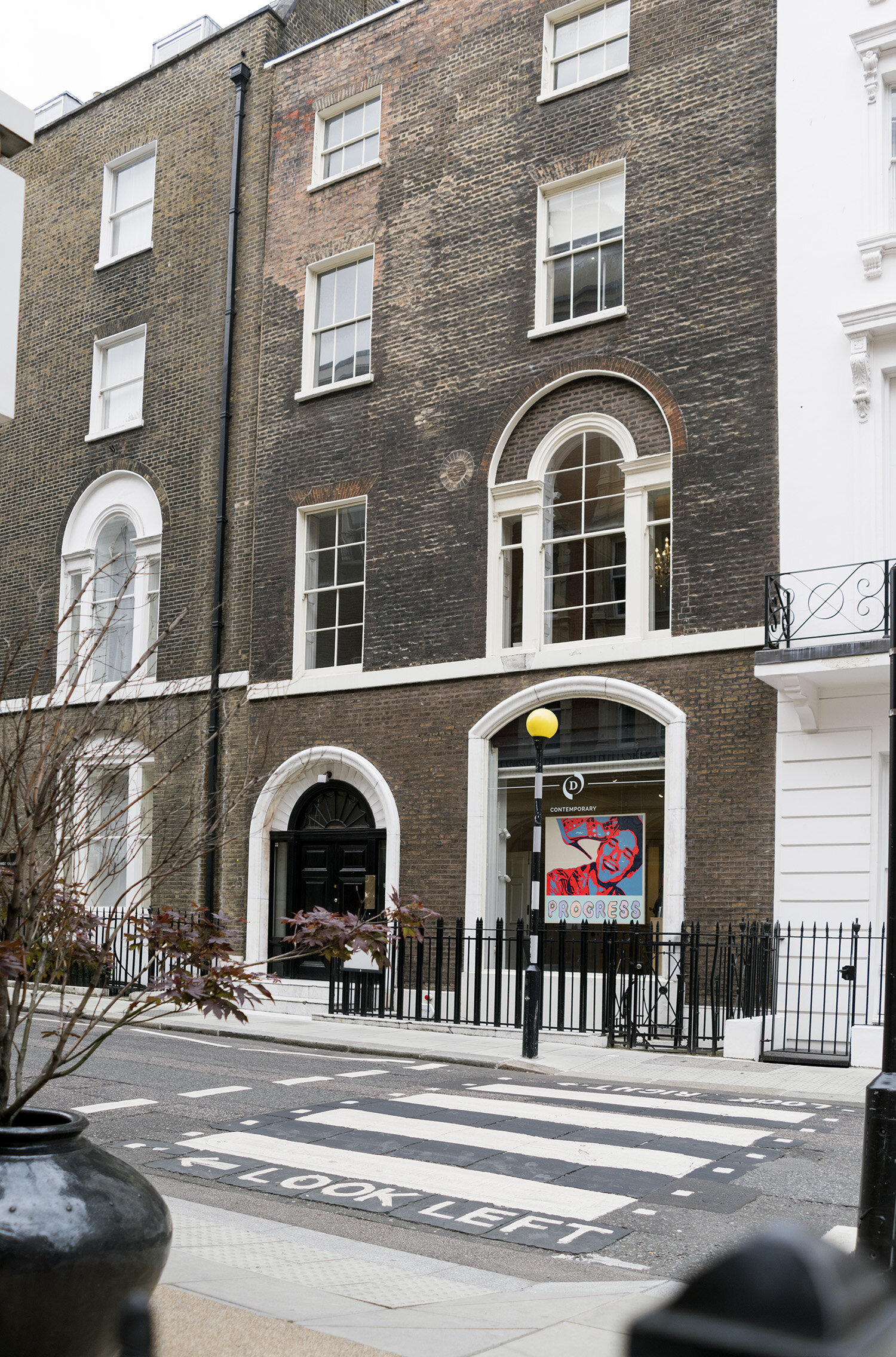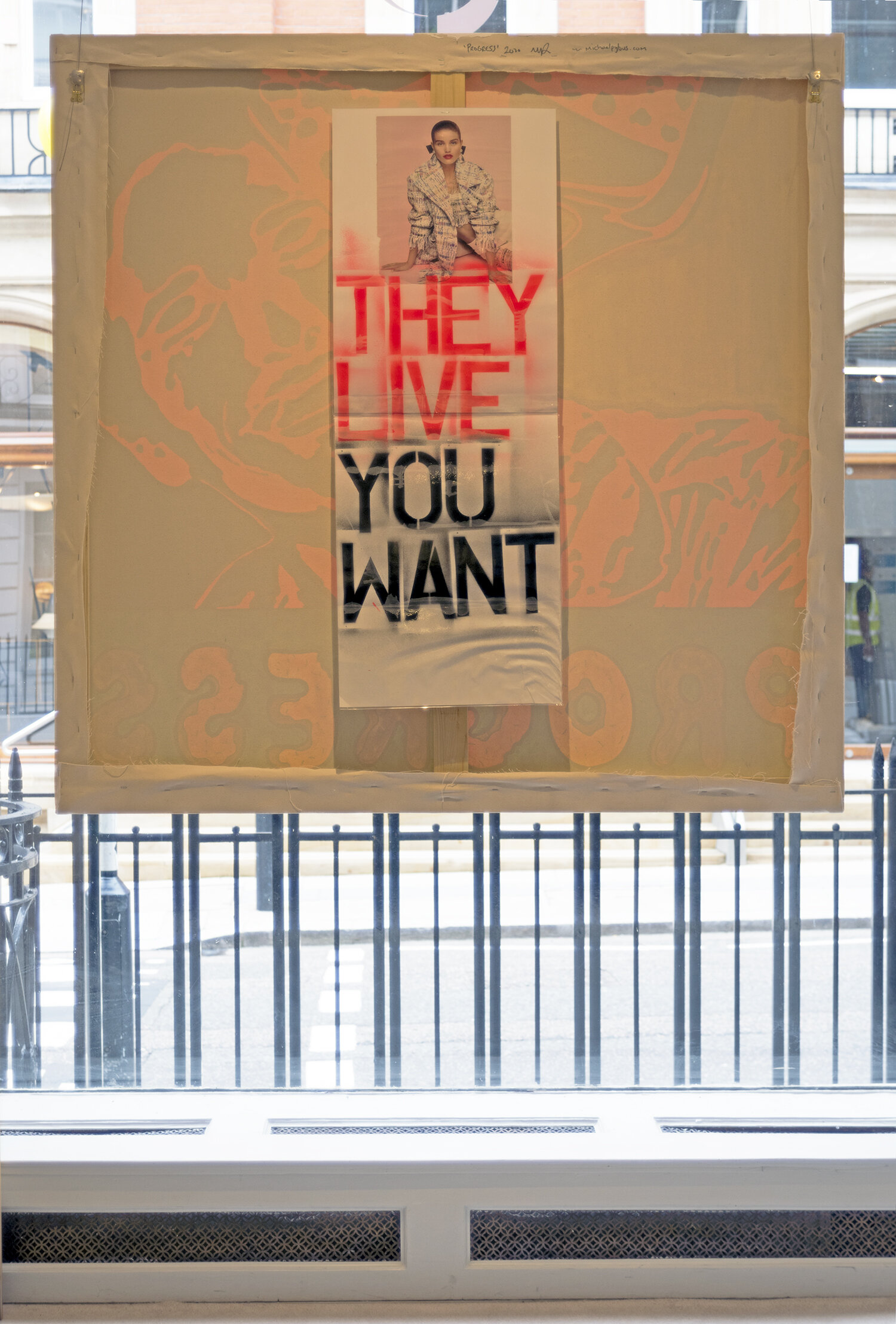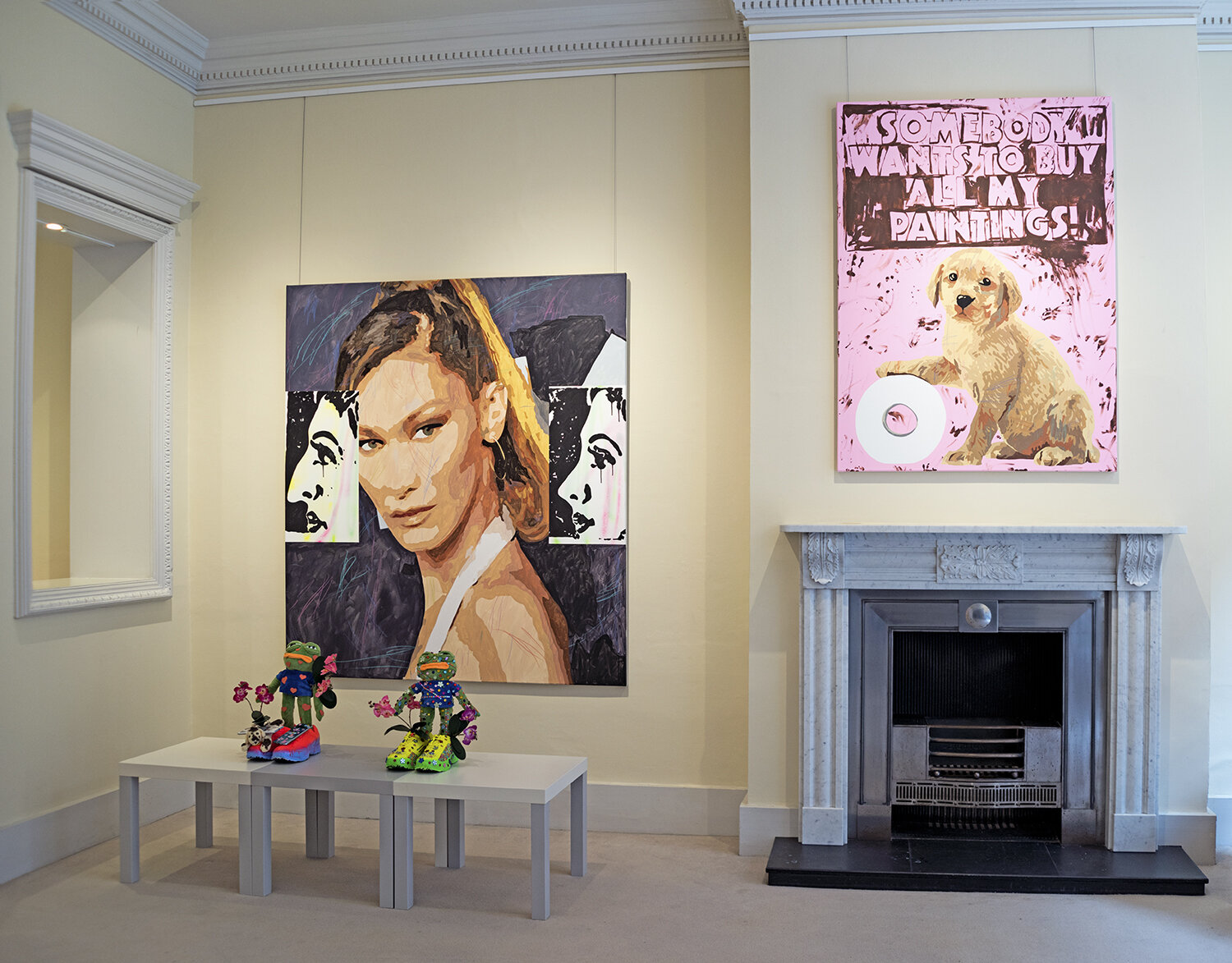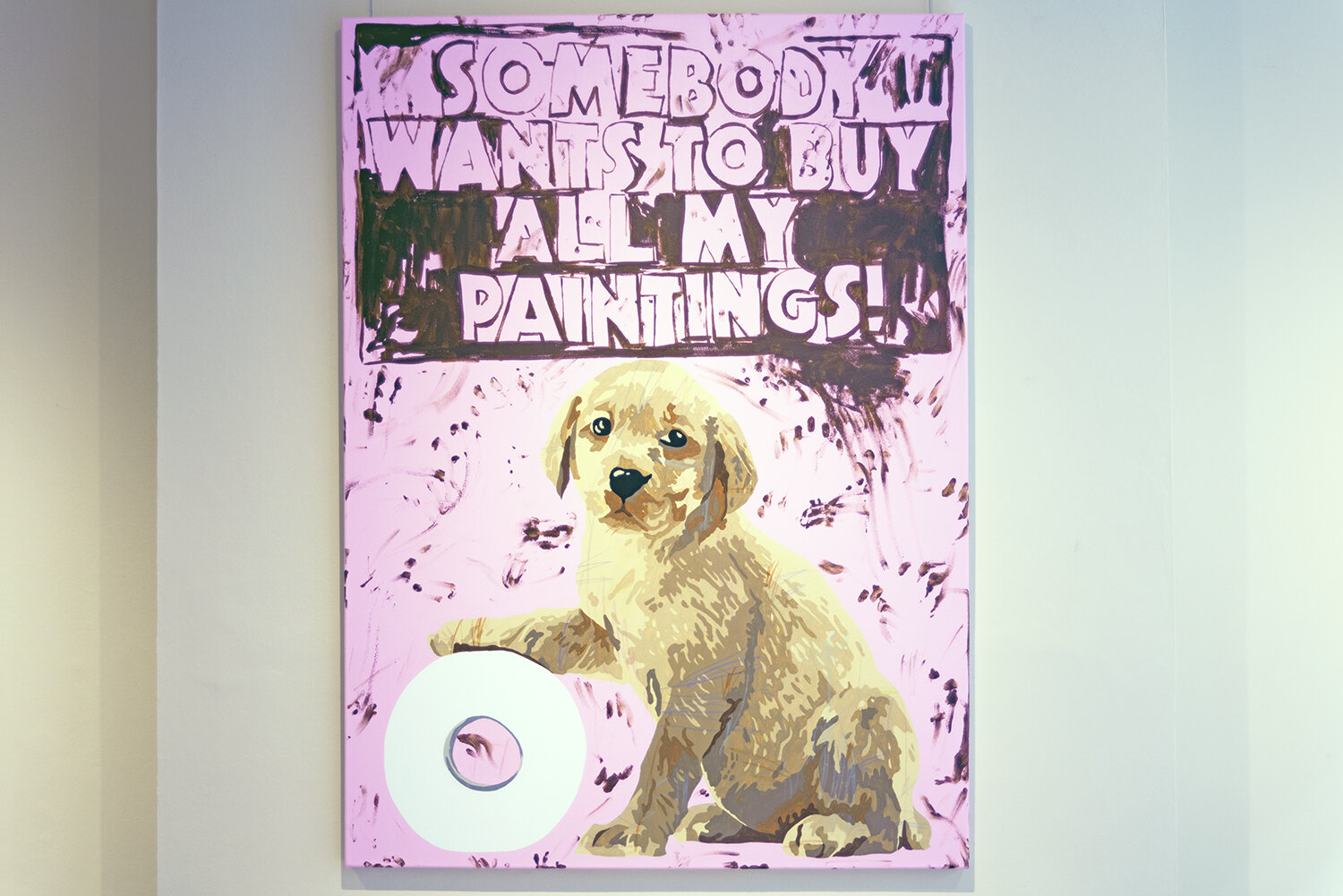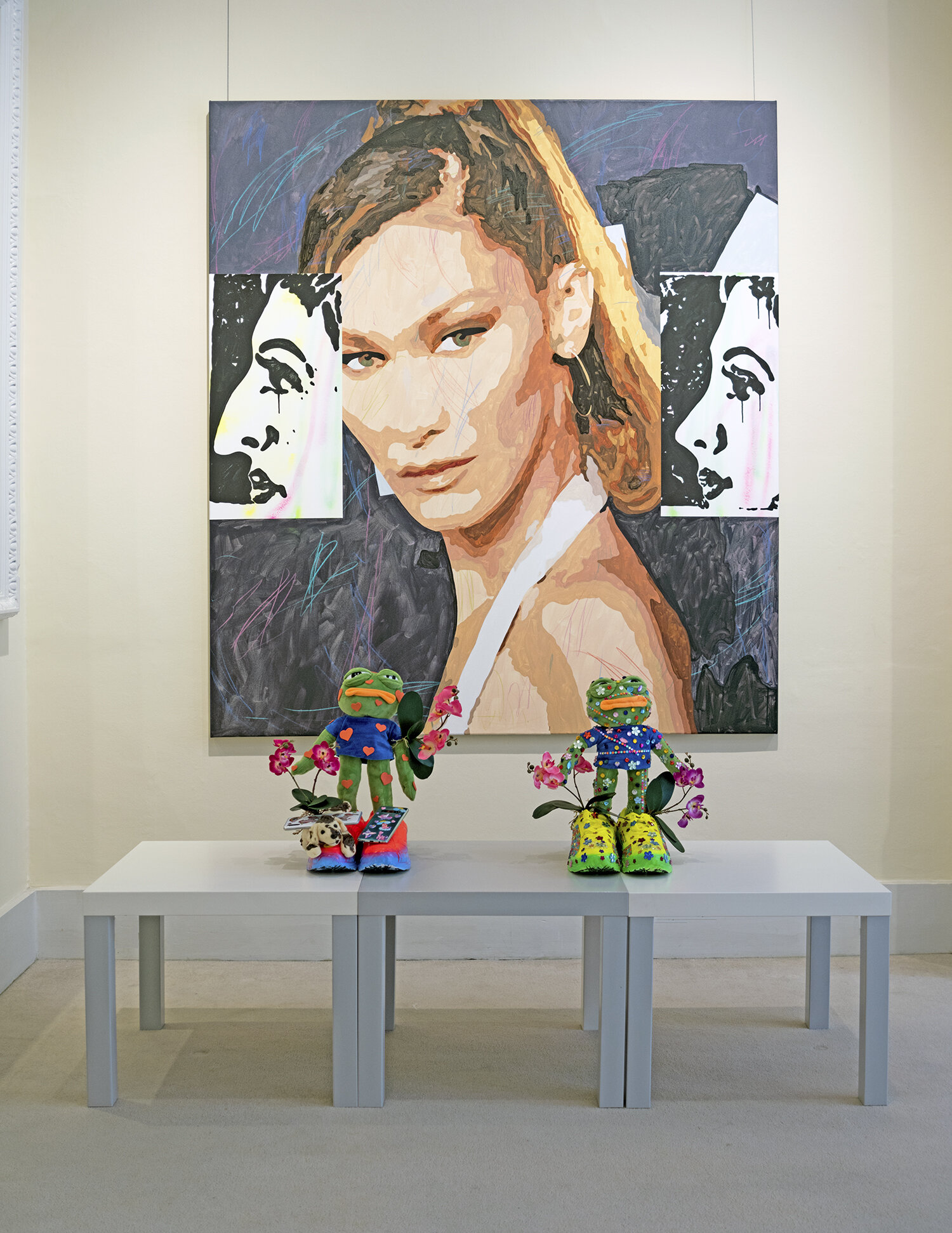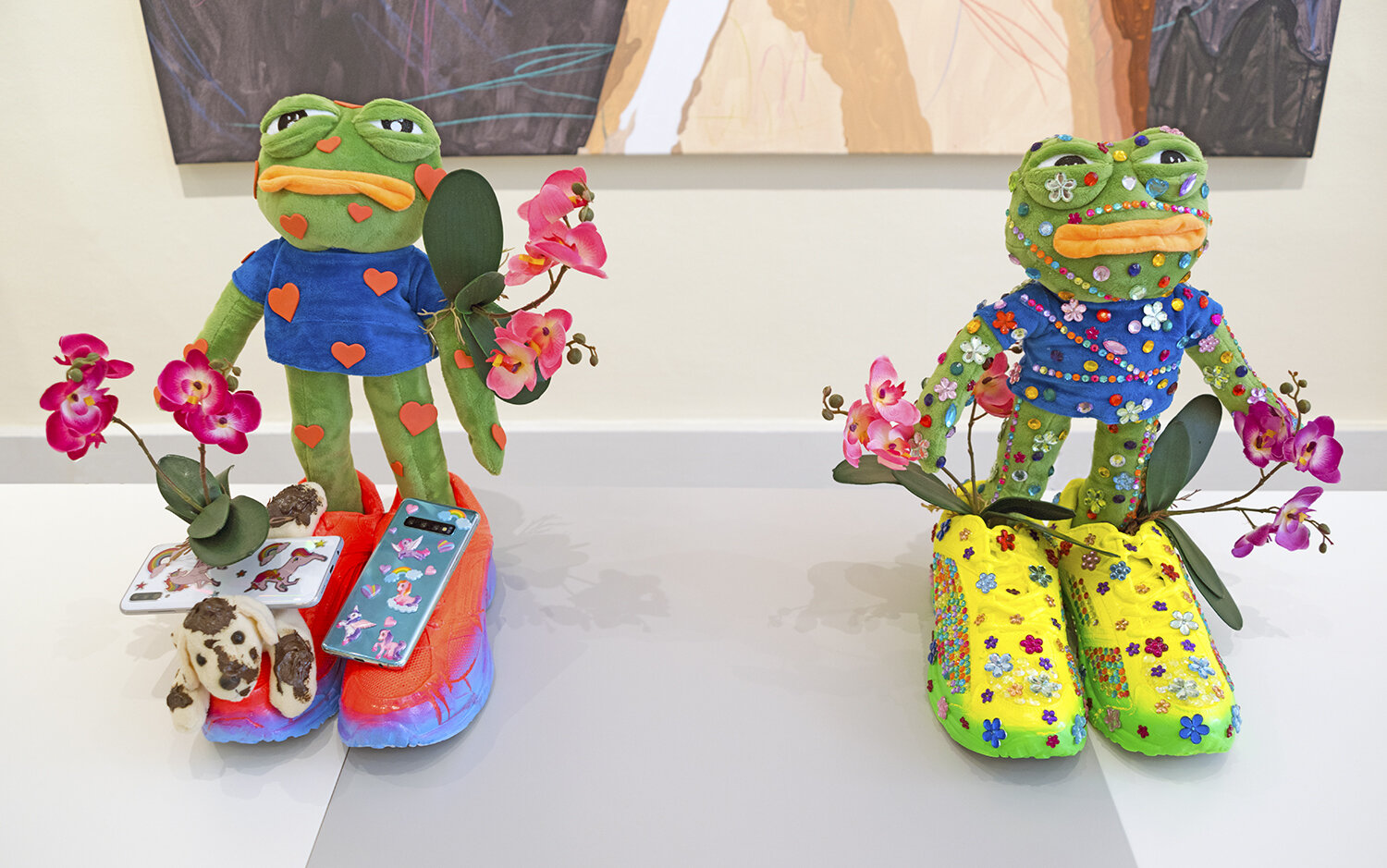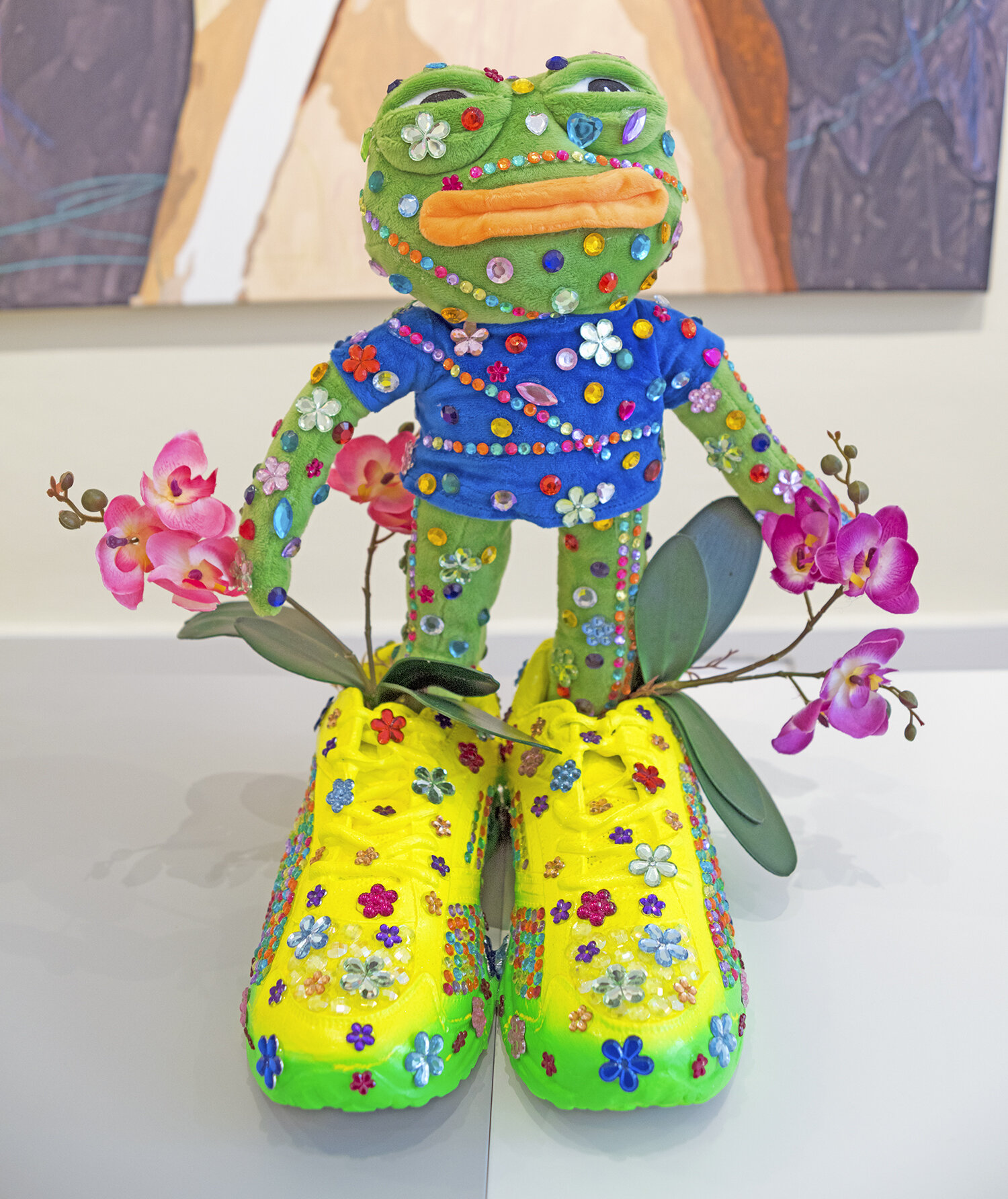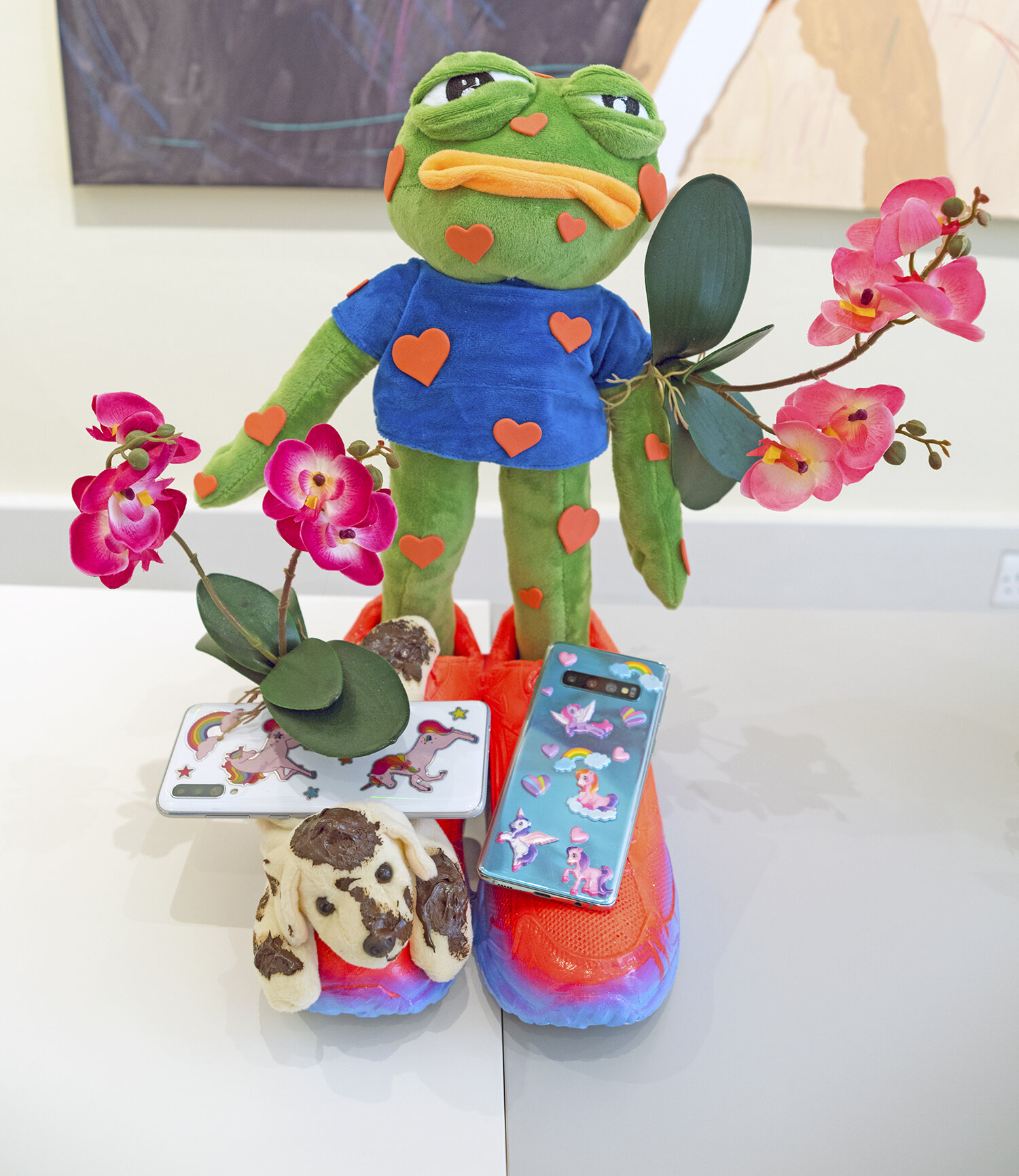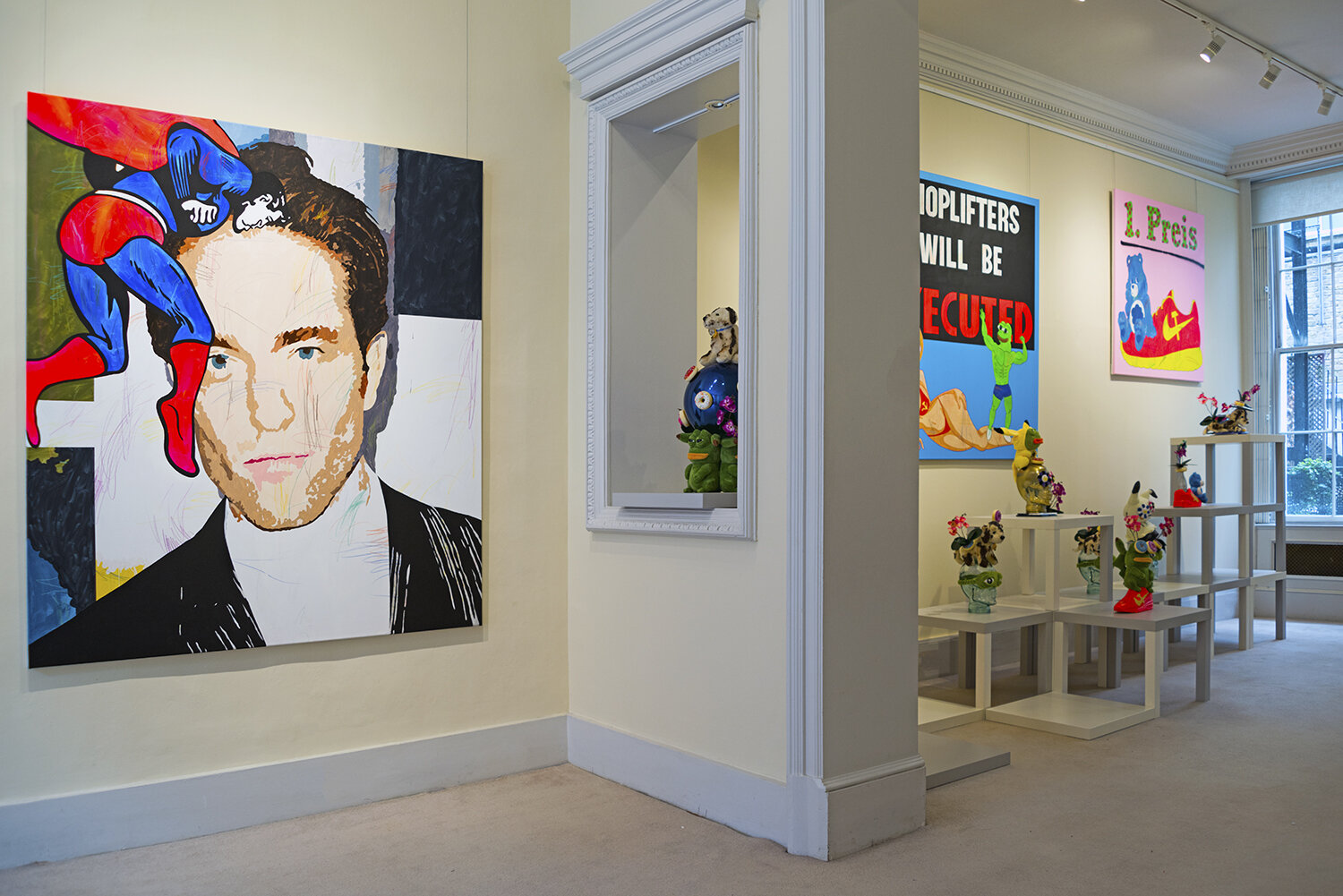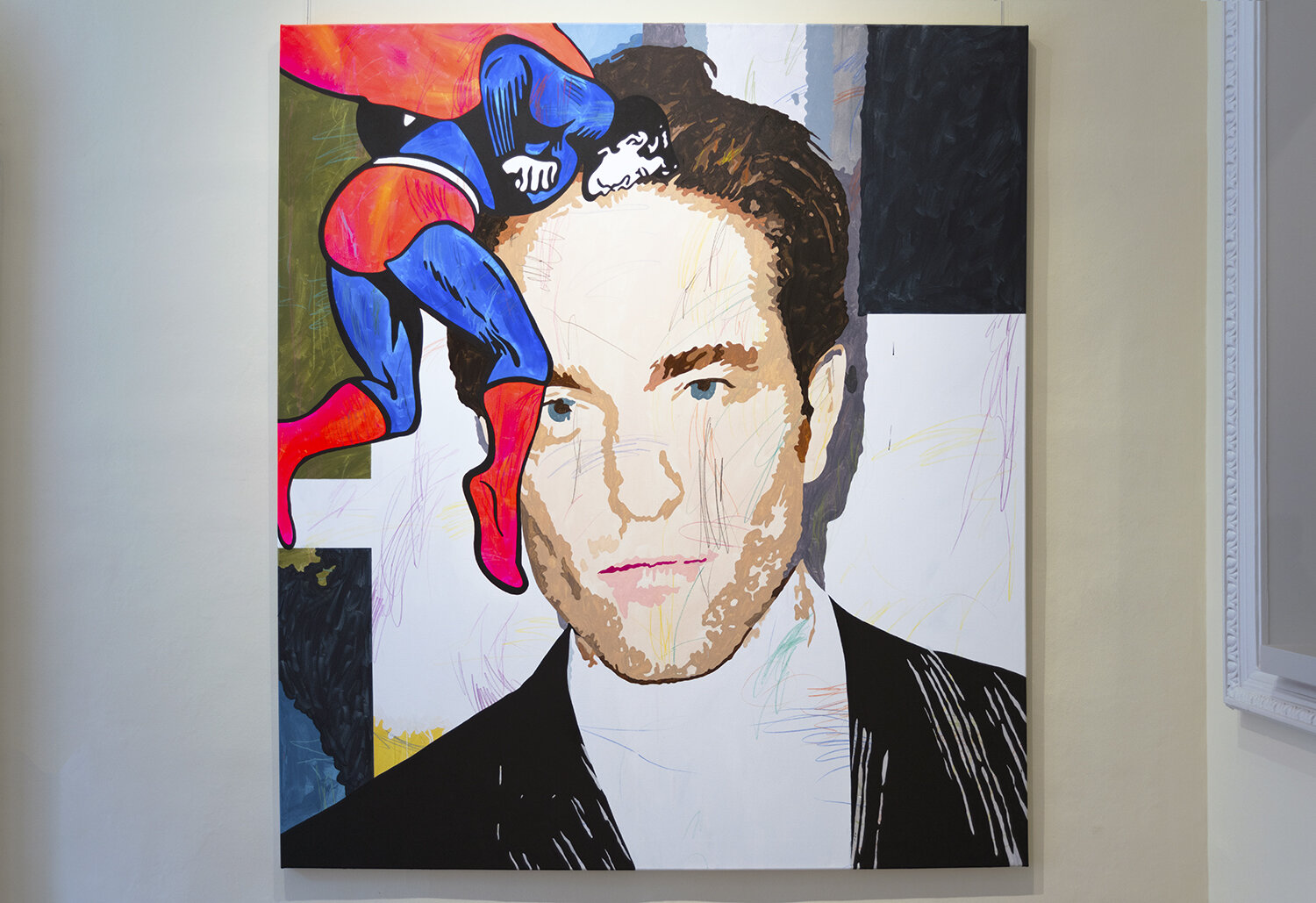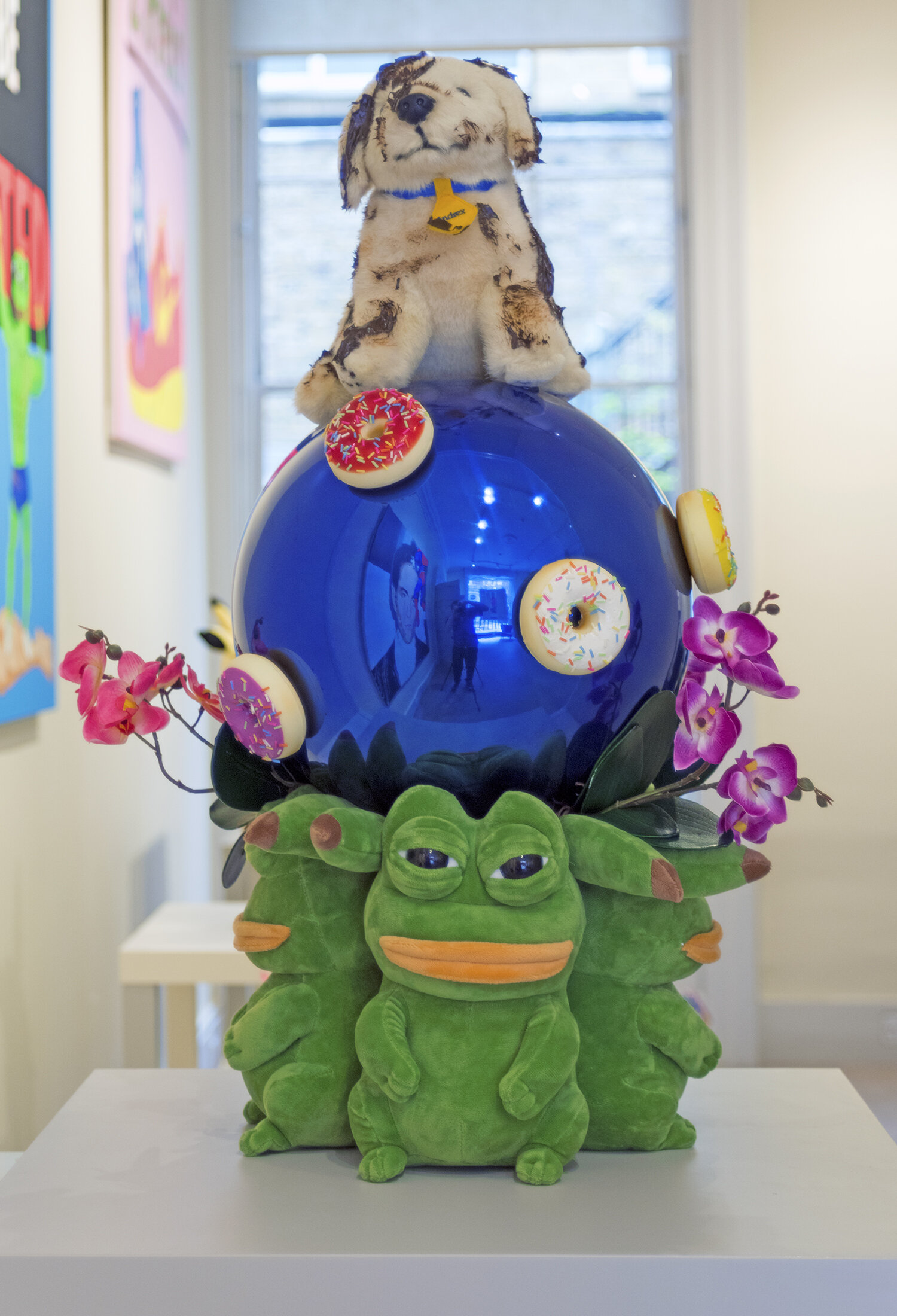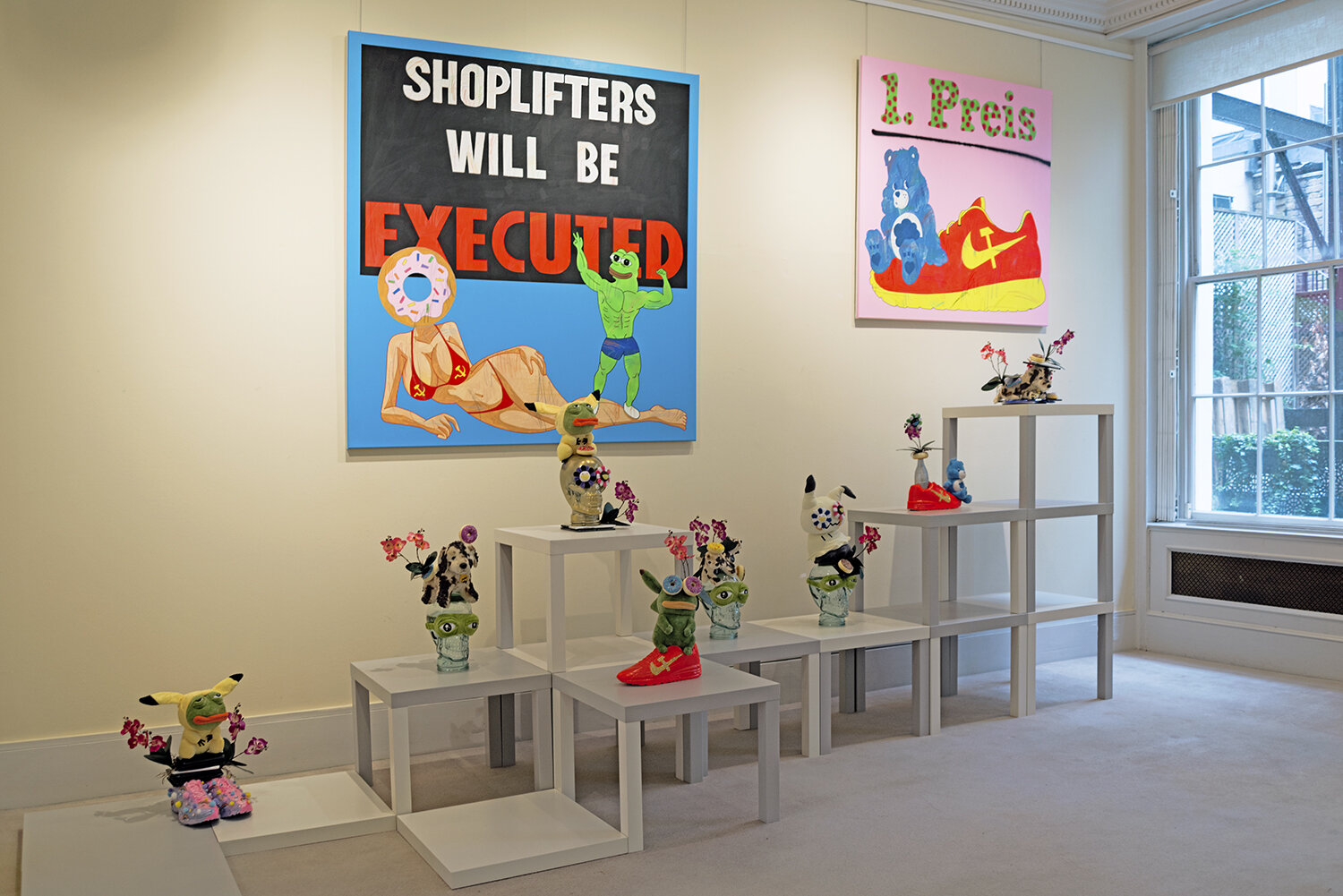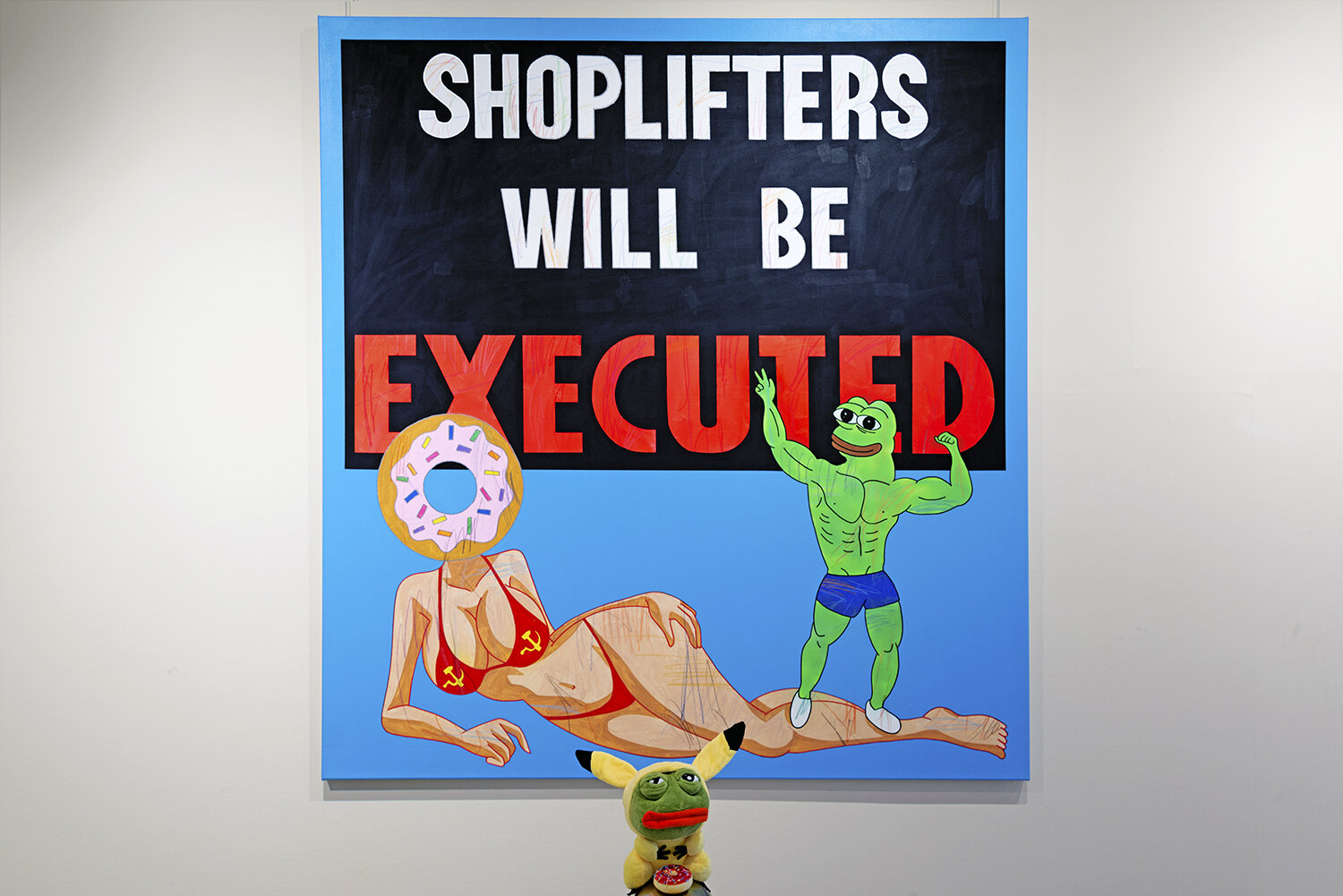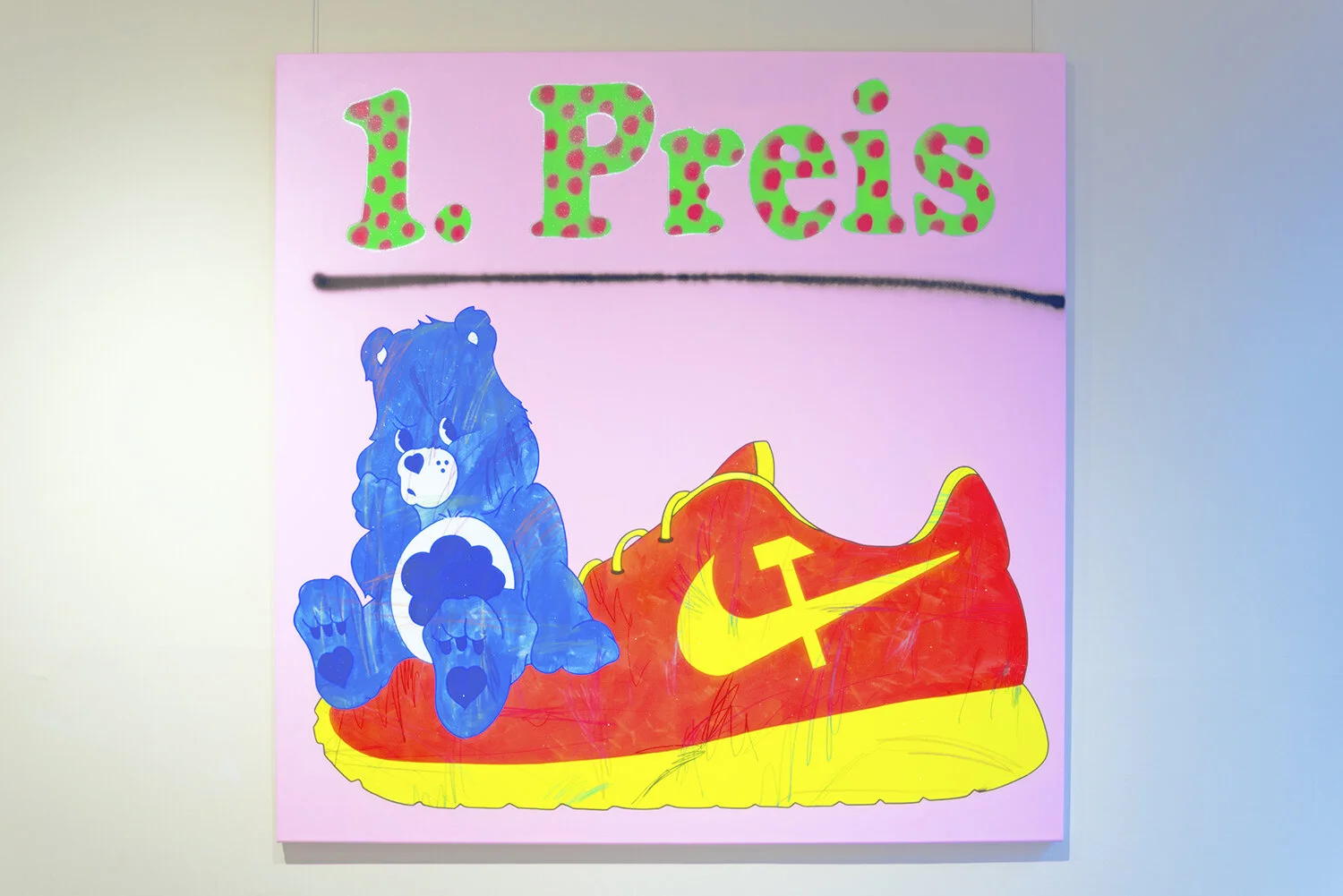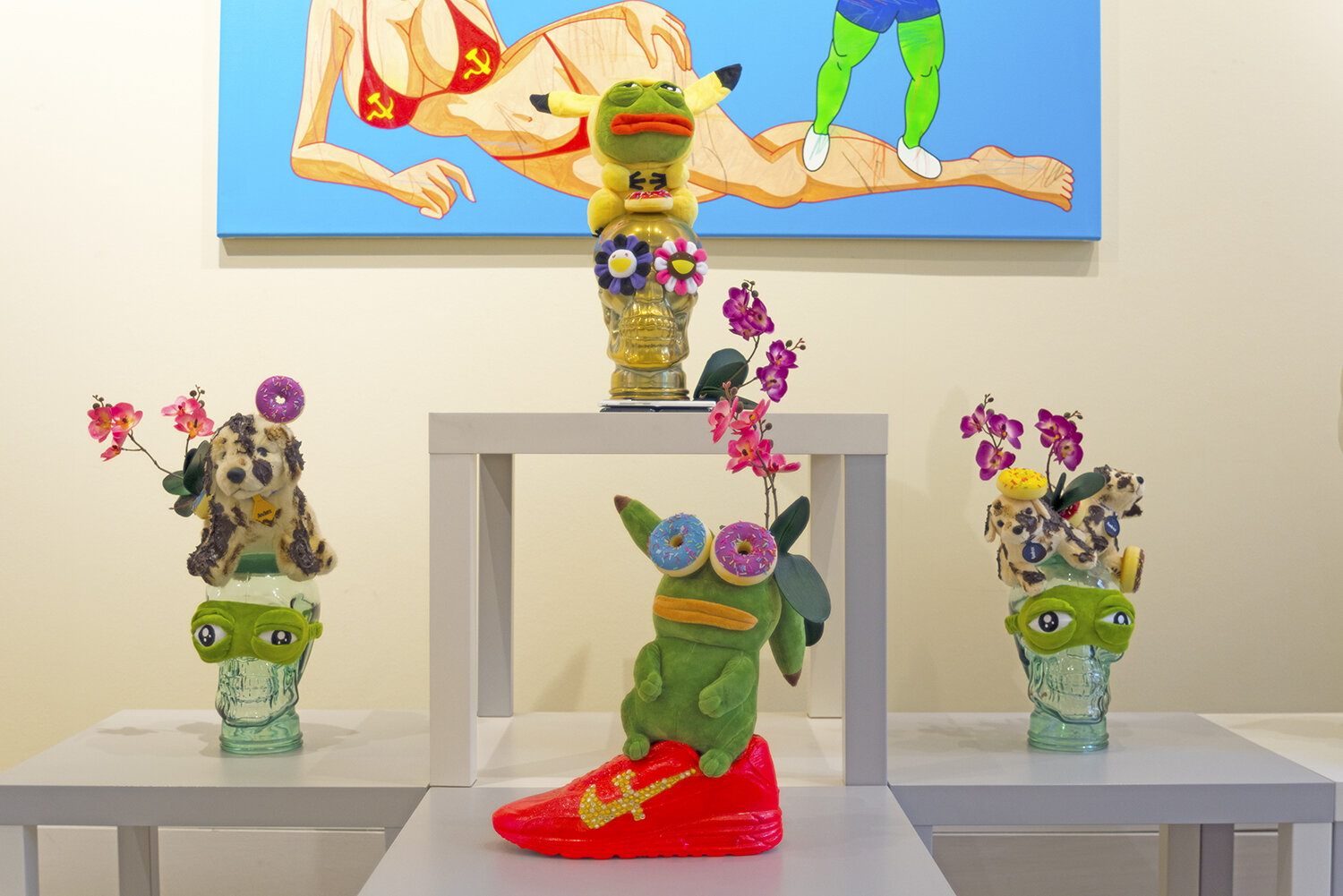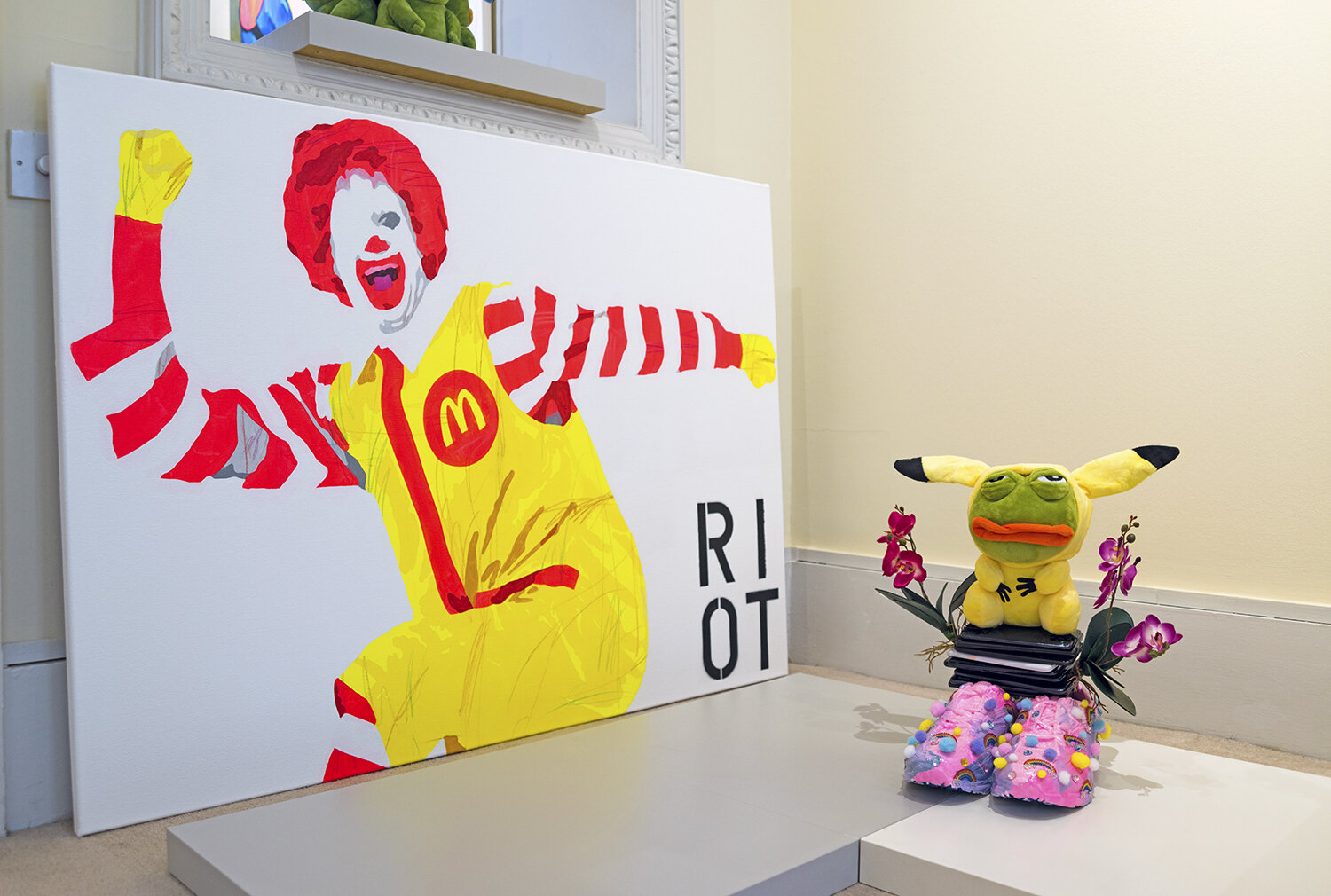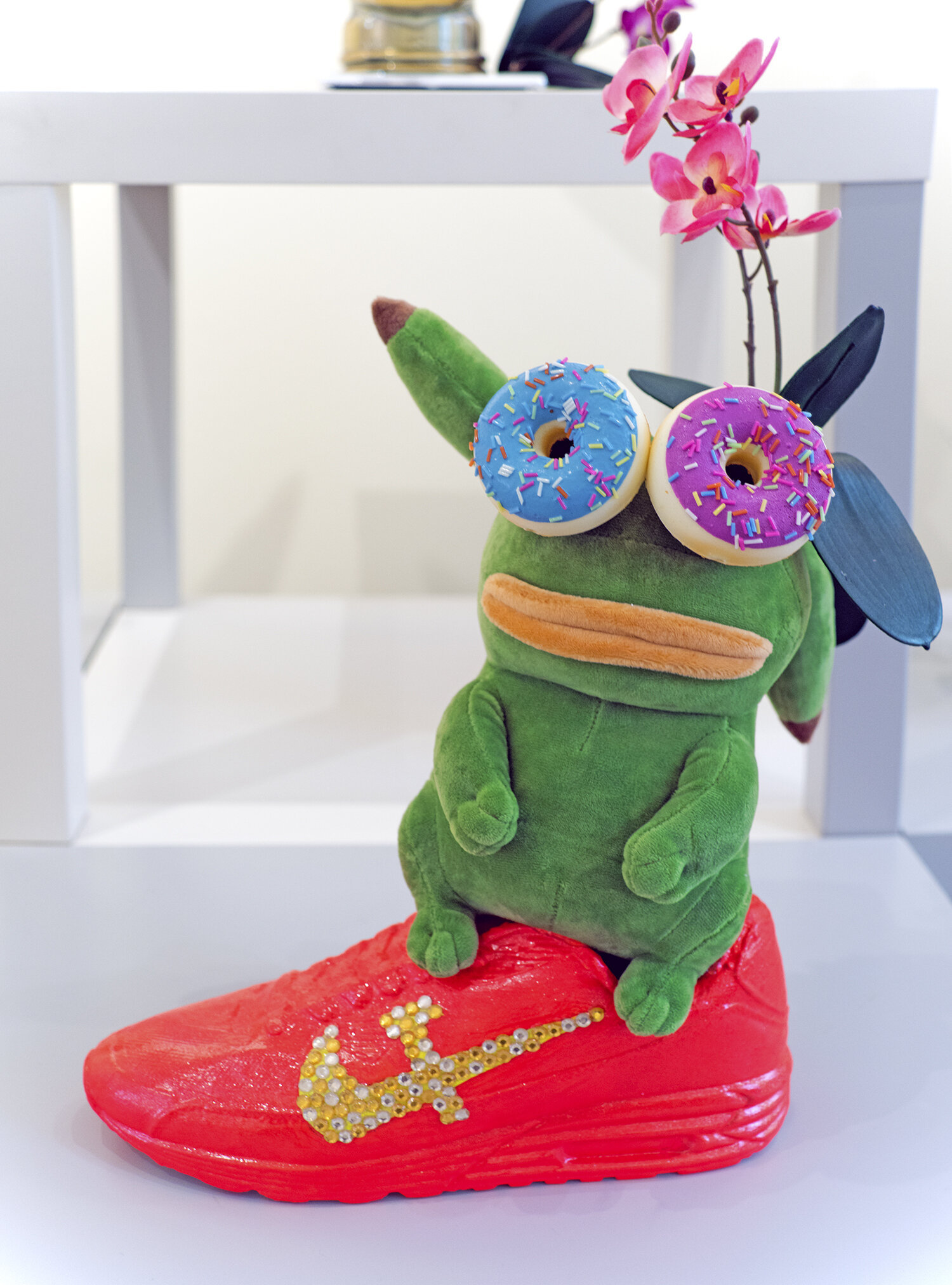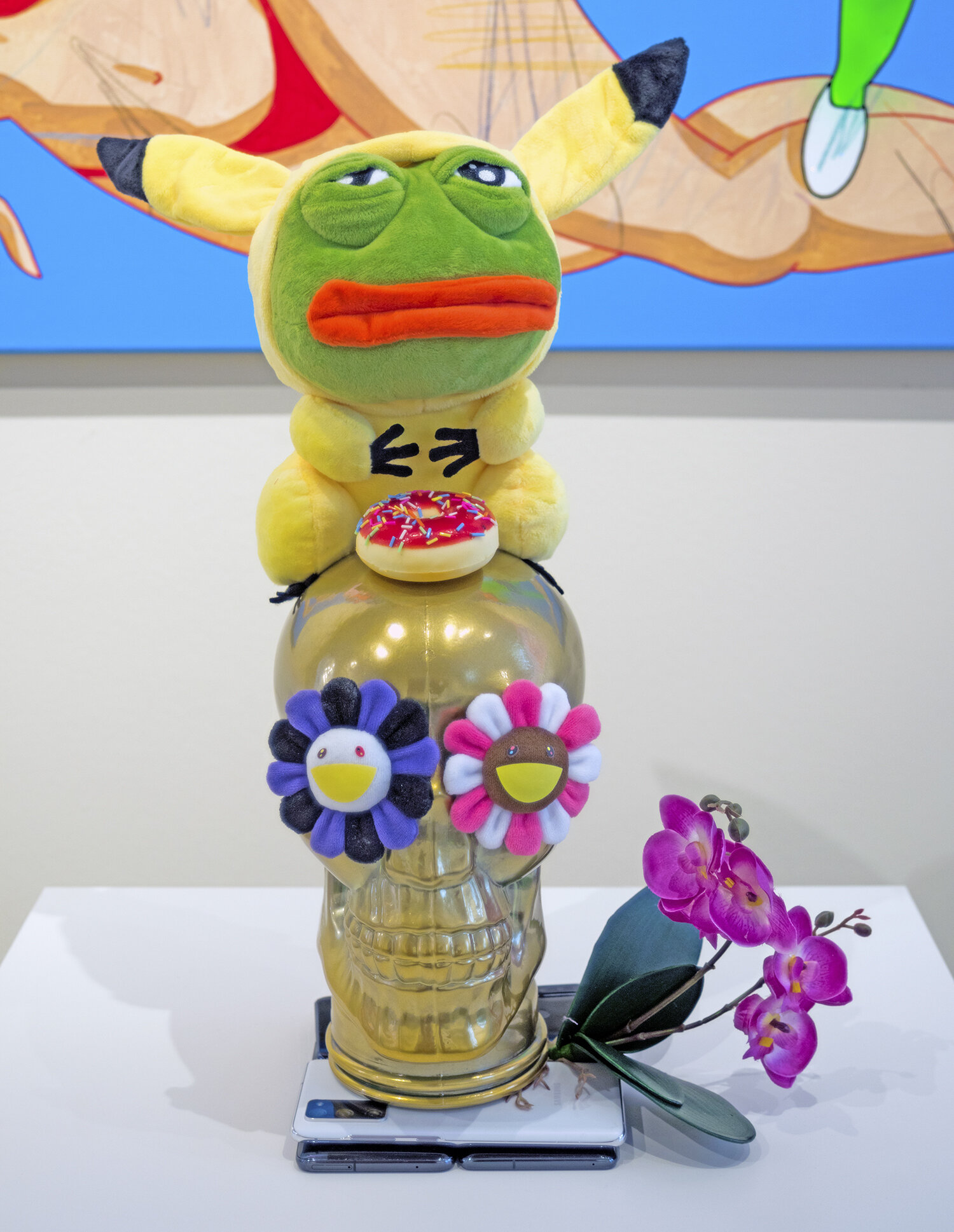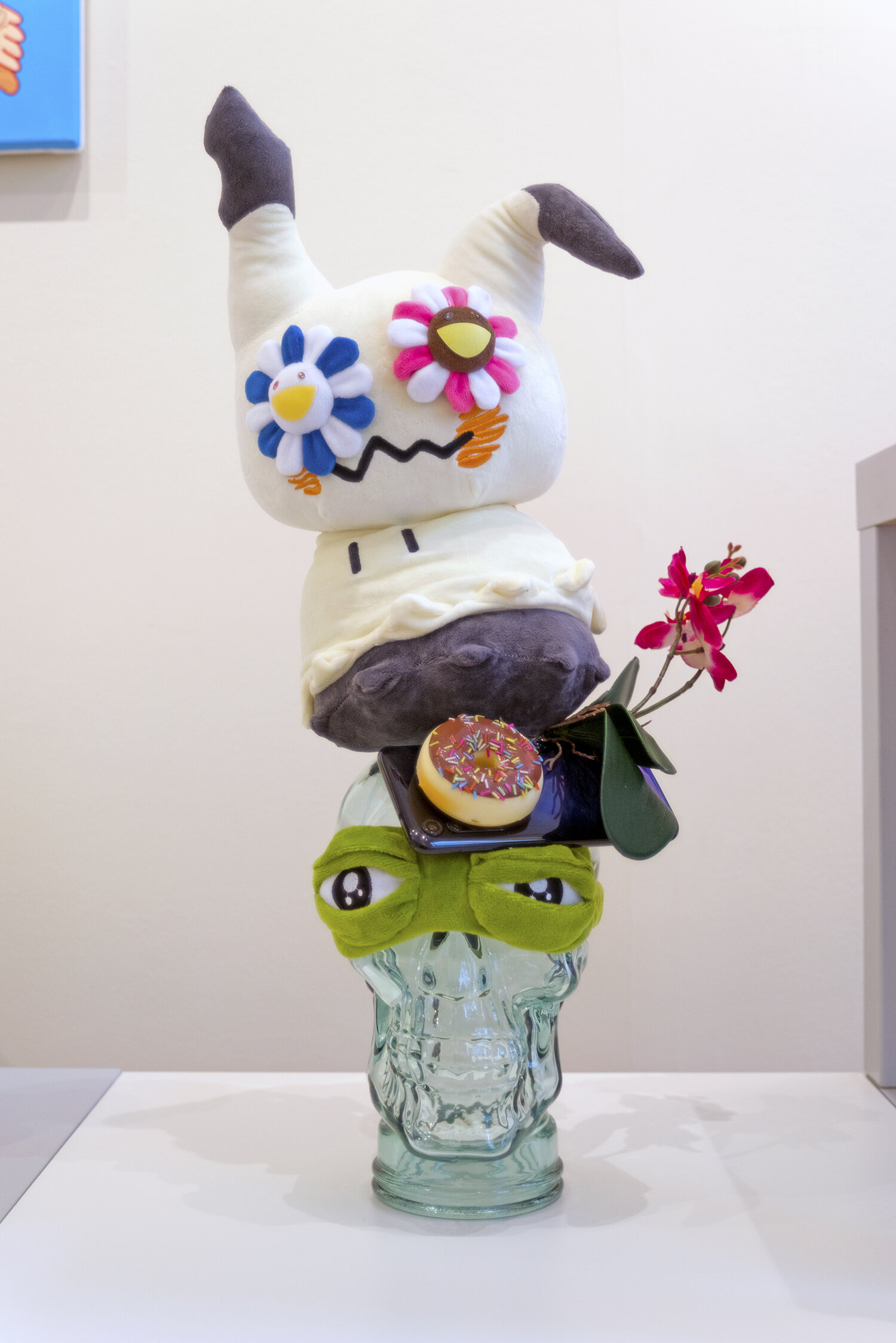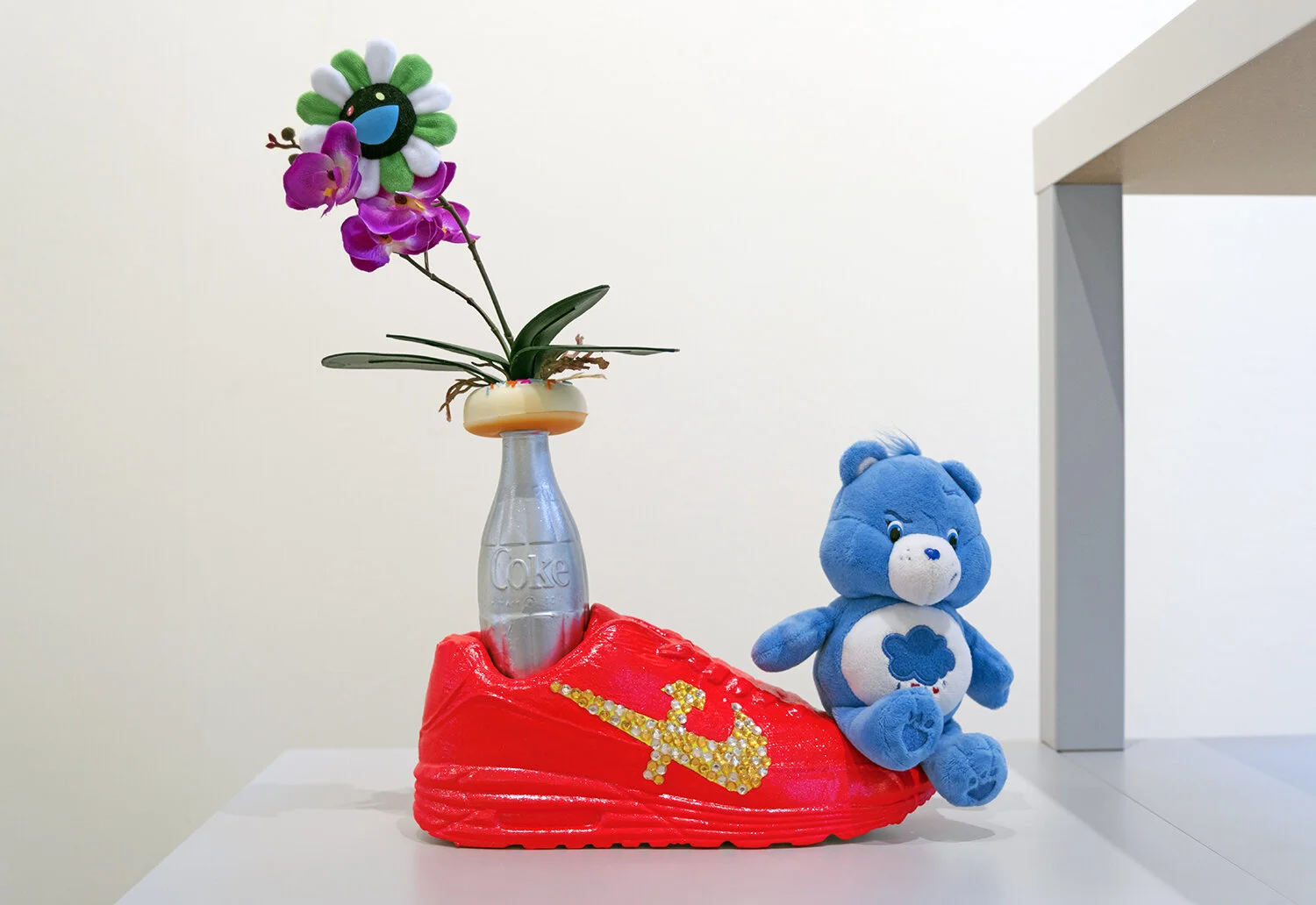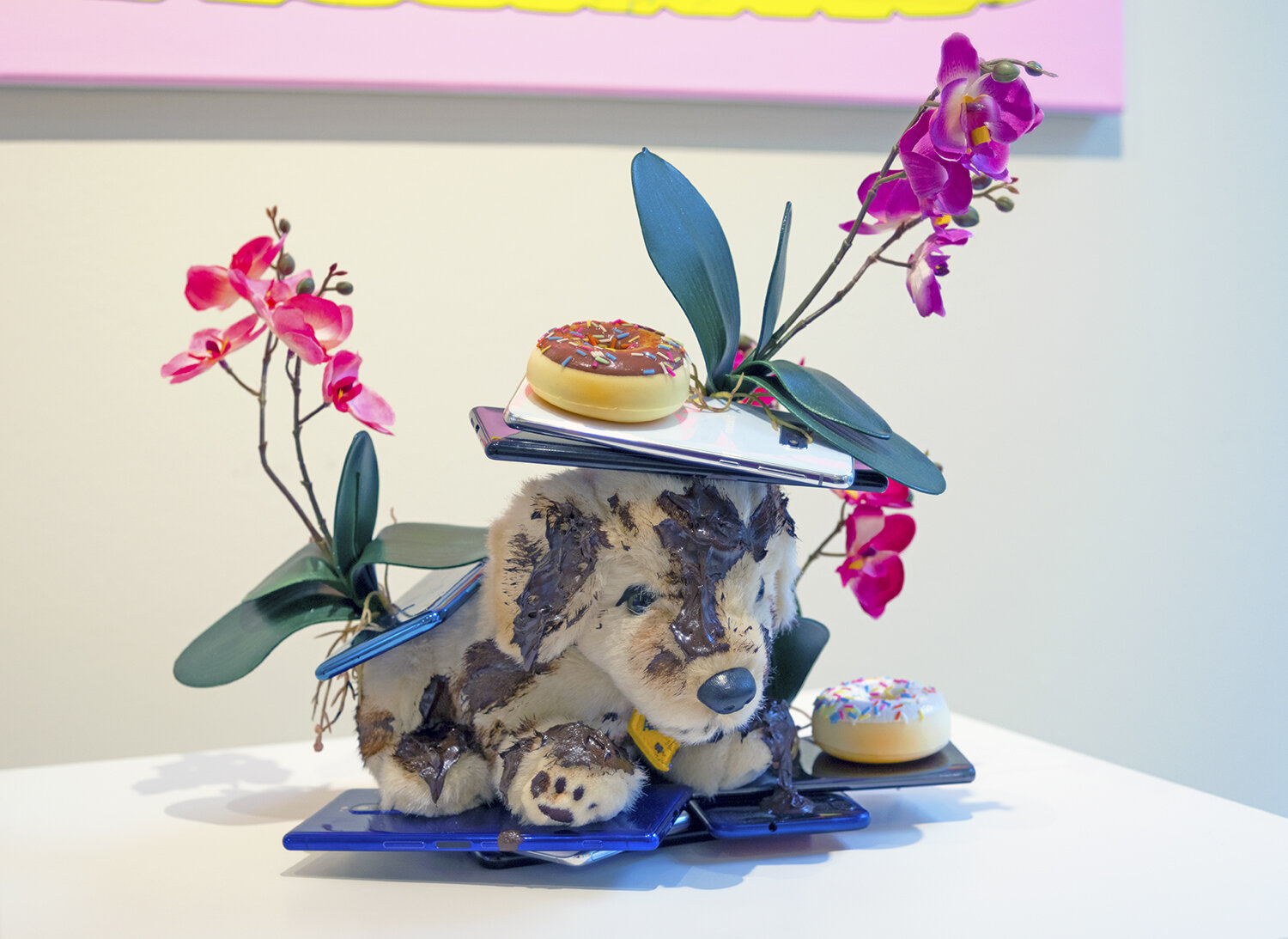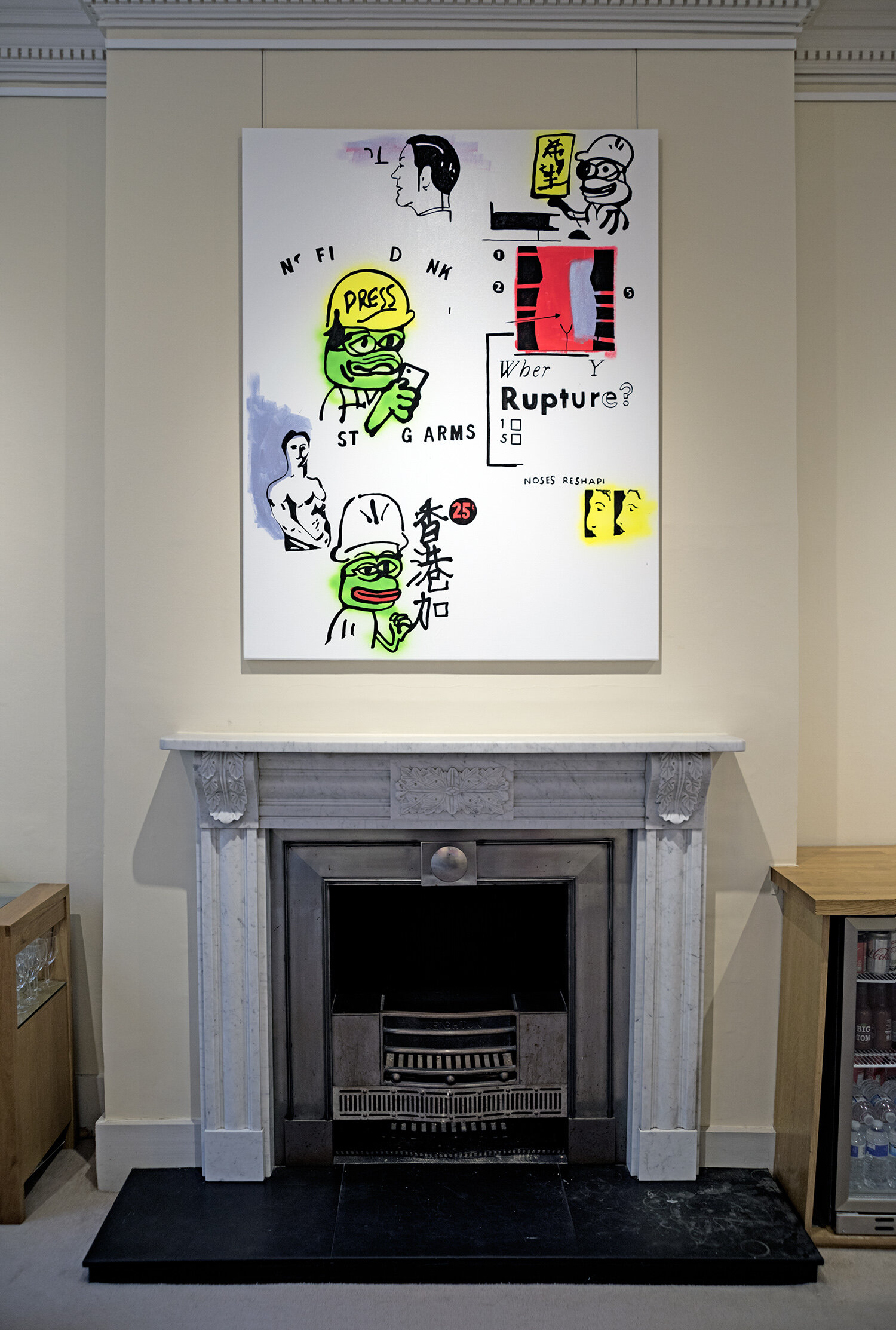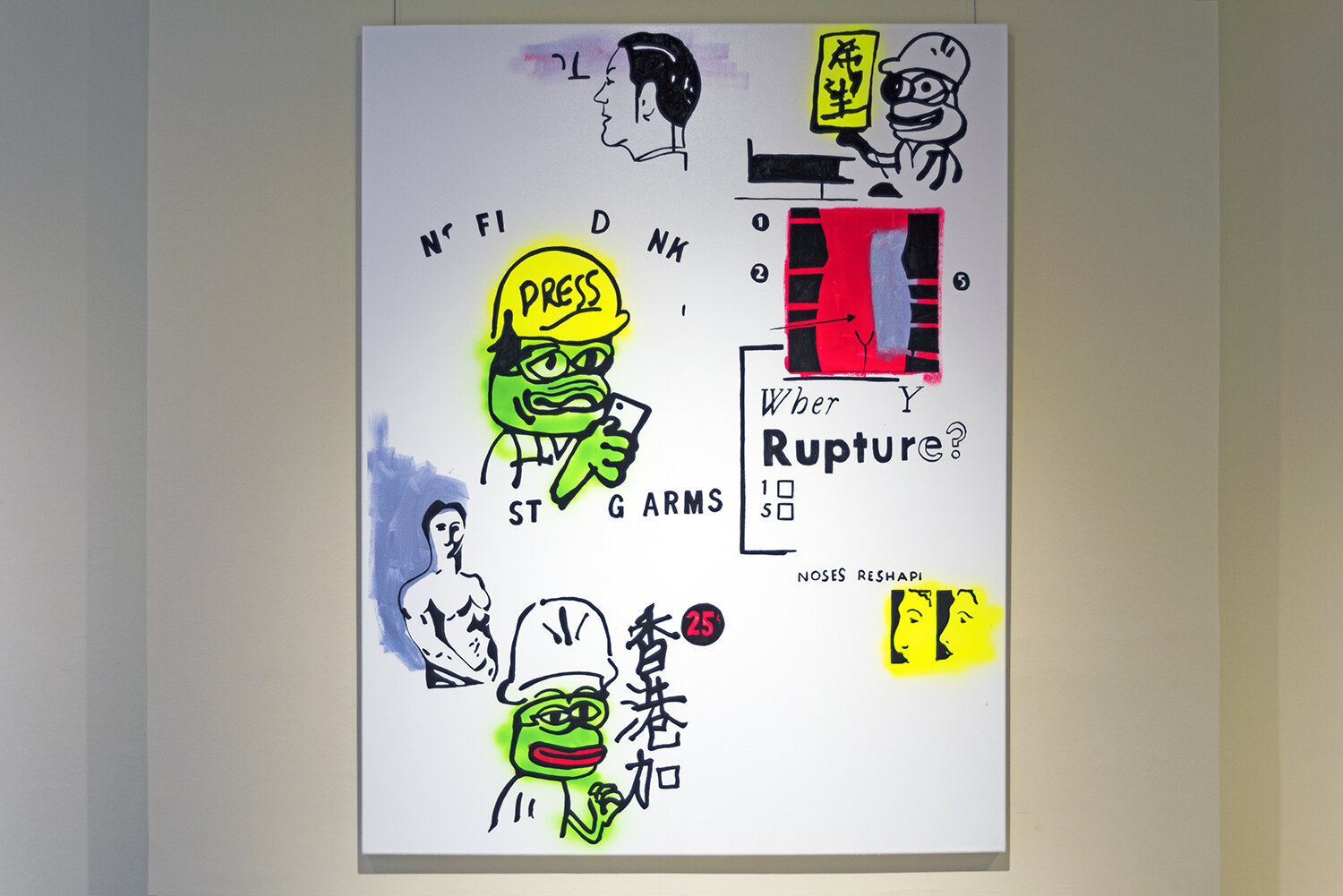CORPORATE SCULPTURES
D-Contemporary London, UK
25 - 27 June 2021
Sampling from a multitude of sources Michael Pybus reimagines contemporary culture by remixing the icons, brands and franchises which permeate our lives. Using a window display created by Andy Warhol for a luxury New York City department store in 1961 as a starting point, he will transform D-Contemporary into a retail display, exhibiting a series of paintings and mixed media assemblages that celebrate and parody the aesthetic tropes of rampant conspicuous consumerism.
For his exhibition “CORPORATE SCULPTURES” at D-Contemporary he sat down with Siannon Saunders to discuss this new body of work.
Scrolling through the imagery for the show instantly made me think of Supreme, the cult skatewear brand which is a 12 minute walk from D-Contemporary. A couple of years ago they released a burner phone that originally cost £40 and now sells for hundreds of pounds online. Do you have any thoughts on the brand and do you see any similarities visually?
For sure the aesthetic and hype around their products is definitely something I channel into my work. I think it’s very easy for people to shit all over Supreme and their customers because Supreme operates in the open. They blatantly lay out the mechanics of consumer manipulation, desire and collecting to such an extreme that it can feel uncomfortably explicit, when viewed through the lens of more “subtle” marketing.
It’s funny though, many of the same people who would turn their nose up at someone spending hundreds of pounds on a garment at Supreme wouldn’t think twice about spending the same amount on a garment printed with the VETEMENTS logo. The brand is basically the same as Supreme in that they sell expensive versions of “cheap” designs. It just so happens VETEMENTS configure their marketing to the over-educated fashionista crowd, thus they are “cool”.
In my work I see parallels to these brands in their approach to high/low. How the throwaway can become coveted through re-contextualisation. I’m not claiming I’ve invented the wheel with what I do. That achievement belongs to Duchamp, but following in his wake, my work is my version of his ‘wheel’ in this moment of time and culture.
I find art that can only function in the narrow realms of the “proper” art space tiresome and disconnected from reality. I prefer to cross pollinate this space. I have designed clothing collections, installed complete IKEA furniture showrooms in a gallery and turned a gallery into a children’s ball pit to blur the boundaries between high, low and everything in-between. I openly acknowledge the gallery as an exclusive commercial space where artworks often operate as luxury goods at the top of a consumer spectrum that extends down to the cheap mass market commodities. For the sculptures in this exhibition I’m using those cheap commodities as materials to construct my sculptures which are then transformed into “luxury” products once exhibited in the gallery.
I was reminded of aspirational items from when I was a working-class kid within several of the sculptural works, particularly the inclusion of McDonalds Happy Meal toys being able to replicate expensive items like TY beanies and plastic robot dogs, or something like Andrex being the king of toilet paper, I remember always being impressed when someone had the recognisable puppy roll in their bathroom when I was growing up. Did you consider the duality of these items when they’re presented in one of the richest parts of London?
I grew up working class too. I always noticed if someone had Andrex toilet paper in their home. My first thought was they must have money. It’s a weird observation to bring up in an art world context which is majority made up of people who have lived their entire life cushioned by wealth. I wonder if they clock toilet roll, but like the flip-side? If it isn’t obviously branded do they think cheapskate or this person mustn’t be doing so well?!
Today art and information is accessible everywhere for free. This is a new phenomenon of the 21st Century. Growing up with very high socio-economic ambitions in a very low socio-economic environment was quite a mind fuck. The idea that I could make a living as an artist just wasn’t a reality my family and teachers could comprehend. I understand that, they had no point of reference, there was no art and money in that world, so there was no framework to use to guide me. Luckily I had TV which is where I discovered Damien Hirst & Tracey Emin during that 90s peak YBA media period. Here were a couple of incredibly successful young artists, not making “proper“ art and they spoke with accents that were just as common and working class as mine! They became my template & showed me a career as an artist was a possibility for people like me.
Back to your question, yeah for sure the duality of my sculptures made from cheap objects being exhibited in one of the wealthiest postcodes on the planet is something I am very conscious of. I often use materials, images, aesthetics & brands that are considered “low/mass” in my work to explore how as a culture we place value onto objects, ideas and even people. The works are autobiographical in a sense reflecting my transitioning from a poor background into being an artist operating in the rarified & exclusive environment of the art world.
Elements of the works included here reminded me of a passage from Julia Kristevas’ Powers of Horror; “The clean and proper (in the sense of incorporated and incorporable) becomes filthy, the sought-after turns into banished, fascination into shame.” Do you feel the retail-style display you've created will make people find certain works more palatable?
Put anything in a gallery and it becomes more palatable. Galleries (and artists) often work so hard to pretend that the exhibition is all about the art and any suggestion of the gallery space being a showroom for commercial enterprises is shied away from. This exhibition may be full of sculptures covered in “shit” but the really unpalatable element here is my direct celebration of commerce & retail display. The works unapologetically offer themselves up to be coveted after and bought.
Pepe the Frog is featured heavily in this show, could you speak about how you came to work with this character?
Pepe the Frog is an Internet meme. A green anthropomorphic frog with a humanoid body, originated in a comic by Matt Furie called Boy's Club from the early 2000s. Pepe became an Internet meme as his popularity steadily grew across Myspace, Gaia Online and 4chan in 2008.
Around the time of the 2016 US presidential elections a false trolling rumour was circulated through the websites 4chan and 8chan inferring that Pepe was actually being used as a symbol of far alt right groups. As media and people these days are always on the lookout for something new to be offended by, they took the bait and the innocuous frog was now believed by many “progressives” to be a hate symbol & was also used by some conservative people as a figurehead. Many claimed the use of the Pepe meme should be banned because it “offended” them, which of course just meant people memed Pepe even more. Pepe continued to be framed as a hateful figure in the mainstream and “liberal” circles for a few years until in an unexpected twist Pepe was co-opted by people in Hong Kong who were protesting against the anti-extradition bill protests (2019 -ongoing). They used Pepe as the face of their cause. In doing so he became a symbol for liberty and resistance against the Communist Chinese Party’s interference with their freedoms and rights.
As an artist there is a pressure, especially into today's hyper sensitive social media dominated times to only work with ‘safe’ images and ideas that are purely decorative or support the mainstream ideologies and dogmas (easily “likeable”). Pepe’s social media beginnings and political evolution of him being seen as a ‘bad’ image attracted me to incorporate him into my work, as he is one of the “worst” images an artist in the West can work with today.
I like to challenge myself and my audience with what I do, both visually and conceptually. Very much following on from “bad” painters such as Kippenberger who actively provoked the bourgeois establishment's aesthetics and ideas by making confrontational and at times sensational works that forced them to re-evaluate what they were comfortable with an artist to producing.
The celebrities that you’ve chosen to depict have recently become either memes or have become newsworthy based on their political views. Were these pieces based on these incidents or are their presence coincidental?
My starting point for this exhibition was Andy Warhol’s 1961 window display for Bonwit Teller, New York where he displayed a series of his paintings as backdrops to mannequins wearing the latest fashion trends.
D-Contemporary, the gallery in which I was invited to do this show in, has a huge street facing window on the same street as mega money shopping destinations like Victoria Beckham & David Zwirner. With Warhol's early window display in mind I’ve embraced the commercial narrative of the location to make an installation that celebrates and parodies wealth hierarchies, conspicuous consumption, product fetishisation, marketing & value systems.
One of the paintings in Warhol’s display was ‘Superman’ (1961). It got me thinking 'who is a Superman today?’ well they would be a celebrity for sure. This led me to read a feature claiming Robert Pattinson is the most handsome man in the world according to science and the Golden Ratio, so I reimagined Warhol’s Painting with Robert Pattinson taking center stage. The same article claimed Bella Hadid is the most beautiful woman in the world. She has allegedly had a lot of cosmetic surgery including rhinoplasties, so I reimagined Warhol’s painting of a nose job advert “Before and After” (1961) with the inclusion of Bella Hadid’s impossibly perfect face.
Robert Pattinson & Bella Hadid are hugely lucrative commodities in the commercial sector. Their faces and bodies are used to display and sell millions of dollars worth of goods globally. For all intents and purposes they are living versions of inanimate mannequins which stood in the Bonwit Teller shop window.
I read recently that ‘capitalism breeds innovation’ - what do you make of this statement?
It breeds a lot of things, some good, some bad, but yeah I’d say overall it is a massive driver or catalyst for innovation, however you need to be innovative to take advantage of it otherwise it could be argued capitalism breeds greed and laziness.
Growth, wealth, living standards, life expectancy, inventions, medical treatments, comfort, knowledge and quality of life has exponentially grown and spread to more people since the Industrial Revolution than at any other point in history. We don’t witness much innovation, freedom and high living standards in Communist societies do we?
It’s so easy for people to shit on the absolute miracle of the modern world when they are also the ones who are completely benefiting from it. It’s such an ungrateful mindset to inhabit. As if all the abundance and safety we have is just the default to life?!
There’s a term for this which I love, Oikophobia. It means the hatred or dislike of one's cultural home and society. This phenomenon is a natural outgrowth of the way super abundant cultures evolve.
When a society reaches a point where there is such a level of wealth that a broad leisure class can be established, people begin to focus on achieving higher levels of wealth and status in relation to fellow members of that society instead focusing on supporting their society.
Rejecting one's culture (capitalism) is the ultimate in status posturing. By doing so you automatically cast yourself above all other people & ideas that are part of that culture. We see it everywhere today, born out of the social media Hellscape. Narcissism and ego reign supreme as people compete for power by claiming moral, aesthetic & consumer superiority over their society & fellow citizens. Competing in a never ending digital pageant of incessant virtue signalling, Facetuned faces & curated pseudo-lifestyles that depict a world where we all have to swallow the lies as truths.
